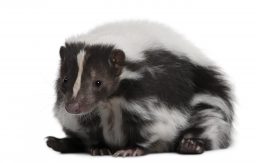Skunks live across the Americas from Canada to Chile. They settle near woodlands, rocky outcrops and open farmland where their insect and rodent prey are found.

Where Do Skunks Live In The Wild?
In North America – there are skunks almost everywhere – with only northern Canada and Alaska being skunk-free. There are 5 species of skunk found in the U.S, and most of them overlap significantly with at least one other species. Strangely all 5 species overlap on the U.S. and Mexico border – so must be ideal habitat there.
The Striped Skunk (Mephitis mephitis) is the most widespread and the most northern, covering the entire range from Canada to Mexico. It has around 13 subspecies in pockets throughout that range – each specializing in its own area. Some, like the Canada Skunk, are used to harsh snowy winters – and others, like Florida or Californian skunks, often stick rigidly to their nocturnal feeding habits to stay cool.
The Eastern Spotted (Spilogale putorius) and Western Spotted (S. gracilis) don’t overlap but together cover most of the U.S. paired up. The Eastern from Minnesota to Texas and Florida and the Western from Washington and Wyoming to the full Mexican border. Loving any combinations of rocky outcrops and woodland edges – they thrive in a variety of temperature zones.
Down at the border – and with the bulk of their range found on the Mexican side – there is the very long-tailed Hooded Skunk (M. macroura) and American Hog-nosed Skunk (Conepatus leuconotus) – one of the largest skunks in the world. And as a result of not really having any predators – they live in any habitat – from canyons to forests, cacti fields, mountains, and coasts.
What Types Of Places Do Skunks Prefer?
Being a carnivore – skunks have to live in places where their prey are most dense. And considering they eat mainly pest species – this brings them into close proximity to humans as we tend to create the most niches for pests to thrive. Think farms, wasteland, and urban garbage.
Ideally, in the wild, they would look to set up a home in a mix of woodland and open fields. The woodland area is great for finding a den – as some species love to set up homes in old trees – and it also keeps the temperature a teeny bit warmer than open ground.
They like to den underground too – although the more agile Eastern Spotted will sleep up in trees. Underground dens are usually a repurposed red fox den but they will dig their own if needed. Free draining soil is an advantage here for them, and if this woodland is on a hill that keeps them ever drier and warmer.
The open fields are needed for hunting insects and small rodents. Open fields – either wild prairies or farmland – are great foraging sites for their small prey and are often undisturbed at night. Skunks rarely touch the crops or other plants and are often seen by landowners as actually benefiting the land.
Many skunks are also famous for turning over rocks to get at the grubs and bugs underneath – so rocky outcrops, canyons, and coastlines are also a favorite haunt for skunks. They also have a penchant for abandoned farm buildings which tend to attract all sorts of insects and rodents – perfect for hungry skunks.
Can Skunks and Rhinos Live in the Same Habitat?
Skunks and rhinos have different habitats. While skunks are adaptable and can be found in a variety of environments, rhinos inhabit grasslands, savannas, and forests. These two species do not typically share the same habitat due to their contrasting needs and behaviors. However, it is interesting to explore where do rhinos inhabit and how their habitat supports their specific requirements.
Why Do Skunks Live In My Yard?
Although there must be a huge amount of ideal wild habitat for skunks – they will still come into our yards if they need to – or if our yards are perfect for their needs.
Habitat loss is a major factor in wildlife decline and human conflict – but if we build houses and roads on what used to be prime skunk territory – we have to expect the skunks to still be looking for somewhere to live. There is still food here for them – so they need to adapt.
Where they can still dig – they will. Skunks love digging burrows under buildings, porches, and barns – especially if they are undisturbed areas or those covered with structures or overgrown weeds. A generous log pile or abandoned outhouse is like a hotel for them too. They also love it if you don’t have a big dog – or you feed your pets outdoors. A hen house would be even better as a daily source of eggs.
If you have open buildings or trees up the outside of your house – then a skunk may well find its way inside your building and keep coming back. By inadvertently making your home quiet, warm, and full of food (and this includes garbage) – you are creating the perfect urban skunk habitat.






